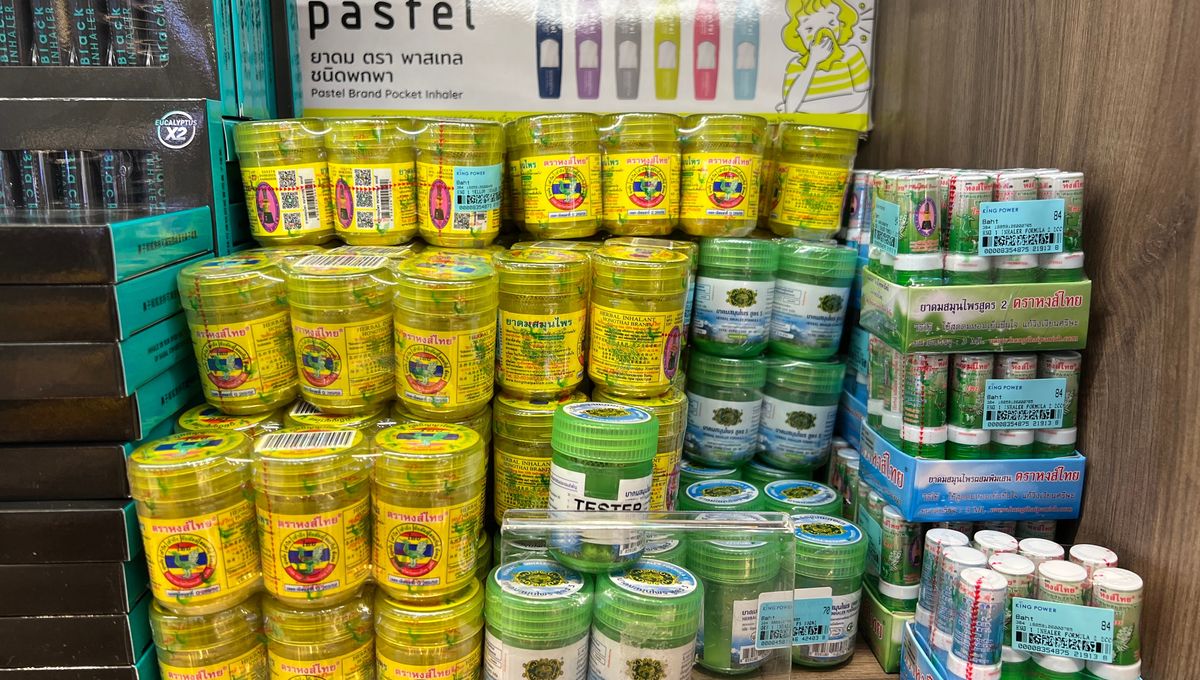
If you’ve ever had the pleasure of visiting Thailand, you might have noticed the locals and seasoned visitors have an unfamiliar habit: holding a little tub up to their noses and gently sniffing. Walk into a 7-Eleven or convenience store and you’ll notice the shelves are stocked with these peculiar plastic jars, each with their own branding and unique selling point.
What is yadom?
ADVERTISEMENT
This is yadom, a variety of nasal inhaler commonly used in Thailand that contains aromatic herbs and essential oils.
Fear not, there’s nothing illicit or illegal about it. It’s even prescribed as a generic household medicine under the order of the Thai Ministry of Public Health, according to the Thailand Foundation. That said, certain people should take care if they’re interested in using this item (more on that later).
The name (ยาดม) loosely translates to Ya, meaning medicine, and Dom, meaning to smell.
To use, people are instructed to open the product, place it under their nose, and gently inhale the aroma. As tempting as it may be, try not to overdo it and restrict using the inhaler a handful of times each day.
Yadom most commonly comes in a handheld plastic tube, with popular brands like Hong Thai featuring distinctive green or yellow branding. One of Thailand’s oldest and most enduring nasal inhaler brands, Poy Sian, has been available since 1936 and is recognizable by its slim white tube. However, yadom also exists in other forms, including liquid inhalers in roller bottles or regular bottles, as well as herbal inhalers made from dried herbs soaked in essential oils, packaged in jars or metal containers.
What is yadom used for?
Yadom is often praised for its ability to ease dizziness, nausea, stress, and faintness. Like a gentler take on smelling salts, its cooling, invigorating aroma is believed to sharpen the senses and revive the mind.
ADVERTISEMENT
The effects of using yadom have not been rigorously tested by peer-reviewed research, although some health authorities have claimed the “benefits of this product are unquestionable.”
Given the limited medical research on yadom, it’s challenging to draw definitive conclusions about its efficacy and safety. While some users report relief from symptoms like dizziness and nasal congestion, these accounts are anecdotal and lack rigorous scientific validation.
Consequently, individuals with respiratory conditions such as asthma or sinusitis, as well as children under 6, are advised to exercise caution or avoid using yadom. As ever, talking to a healthcare professional before incorporating yadom into your daily routine is advisable, especially for those with pre-existing health concerns and respiratory problems.
What is yadom made of?
Different brands use different formulas, but yadom generally contains a mix of three key ingredients: menthol, camphor, and borneol.
- Camphor: Obtained through a boiling process with other compounds, camphor releases a crisp, cooling scent. It’s a key ingredient in cosmetics, ointments, perfumes, and soaps. When inhaled, it may help ease dizziness, while topical application is said to soothe irritation. However, due to its strength, prolonged exposure may cause respiratory discomfort.
- Menthol: Extracted from mint leaves or peppermint oil, menthol carries a distinctively fresh and invigorating aroma. Valued for its soothing properties, it’s widely used in balms, lotions, and skincare products. Inhaling menthol can help counteract dizziness, while applying it to the skin creates a cooling sensation. That said, excessive inhalation may lead to respiratory irritation.
- Borneol: Naturally found in the Dryobalanops aromatica tree and often synthetically produced, borneol is prized for its mild pain-relieving and cooling effects. It is particularly effective in reducing inflammation and soothing insect bites. Its distinctive fragrance also makes it a popular choice in various aromatic formulations.
Other natural oils – such as eucalyptus oil, lavender oil, tea tree oil, orange oil, lemongrass oil, and others – are also commonly used.
Yadom in Thai culture
Yadom has deep roots in Thai culture, with its origins tracing back to traditional herbal medicine practices. Aromatherapy regained prominence in this part of Southeast Asia during the reign of the Siam King Rama II (1809-1824), as documented in the literary work Nirat Phukhao Thong by Sunthorn Phu, which mentions the King’s fondness for fragrances.
Today, yadom remains a staple of Thai daily life, embraced across generations and social classes. Much like Tom Yum, majestic elephants, and golden Buddha statues, yadom has evolved into a cherished cultural emblem of the country, reflecting Thailand’s rich heritage and distinctive traditions.
The content of this article is not intended to be a substitute for professional medical advice, diagnosis, or treatment. Always seek the advice of qualified health providers with questions you may have regarding medical conditions.
Source Link: Yadom: What's Up With The Herbal Inhalers Seen Everywhere In Thailand?